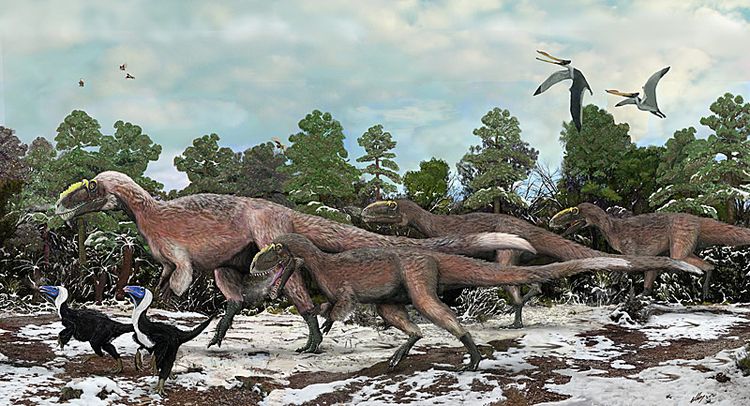Three remarkably complete skeletons representing a previously unknown species of giant, feathered tyrannosaur have been discovered in China. The creature, described in Nature, is the largest-known feathered animal, living or extinct.
Tyrannosaurus rex and its gigantic cousins lived until around 65 million years ago but most of their earlier relatives are thought to have been much smaller. This notion is challenged by the discovery of three specimens of a new species of tyrannosauroid: one adult that is estimated to have weighed over 1,400 kilograms, and two juveniles that may have tipped the scales at a ‘mere' half-tonne. The dinosaur, whose name translates as ‘beautiful feathered tyrant', shares some features with derived tyrannosaurs, but has three-fingered forelimbs and a typical theropod foot, like other early tyrannosaur relatives.
Most notable, however, is the animal's long, filamentous feathered plumage, which provides direct evidence for the presence of extensively feathered giant dinosaurs. The plumage is likely to have had an insulating function, but because the feathers are preserved only partially in the three specimens, the possibility of their having a more restricted distribution on the body and functioning as display structures cannot be ruled out.
Numerous feathered dinosaur specimens have recently been recovered from the Middle-Upper Jurassic and Lower Cretaceous deposits of northeastern China, but most of them represent small animals1. Here we report the discovery of a gigantic new basal tyrannosauroid, Yutyrannus huali gen. et sp. nov., based on three nearly complete skeletons representing two distinct ontogenetic stages from the Lower Cretaceous Yixian Formation of Liaoning Province, China. Y. huali shares some features, particularly of the cranium, with derived tyrannosauroids2, 3, but is similar to other basal tyrannosauroids4, 5, 6, 7, 8, 9, 10, 11, 12 in possessing a three-fingered manus and a typical theropod pes. Morphometric analysis suggests that Y. huali differed from tyrannosaurids in its growth strategy13, 14. Most significantly, Y. huali bears long filamentous feathers, thus providing direct evidence for the presence of extensively feathered gigantic dinosaurs and offering new insights into early feather evolution.

